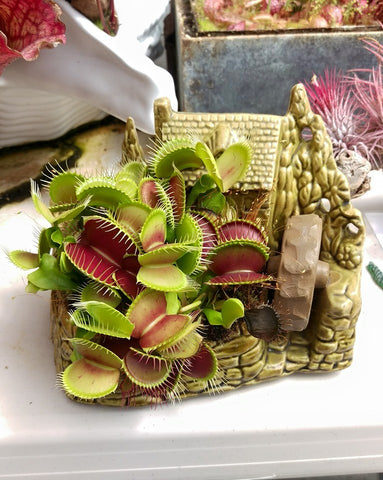General Carnivorous Plant Growing Tips
 Soil: We offer both individual ingredients and mixes for all your carnivorous plant needs which can be found in our Growing Supplies section. Each species requires it's own specific blend but most carnivorous plants should be grown in some mix of peat moss, perlite or sand. Never pot them into regular garden or potting soil; this will kill them.
Soil: We offer both individual ingredients and mixes for all your carnivorous plant needs which can be found in our Growing Supplies section. Each species requires it's own specific blend but most carnivorous plants should be grown in some mix of peat moss, perlite or sand. Never pot them into regular garden or potting soil; this will kill them.
We use professional grade peat moss only. Be careful and do not use Miracle-Gro brand peat and perlite as it has been fortified with fertilizers and will harm carnivorous plants!
We recommend using washed horticultural or play sand.
We use New Zealand long-fibered Sphagnum moss as a base for many of our other plants such as Nepenthes and Heliamphora. Many retail garden centers and nurseries unwittingly sell Oregon green moss as Sphagnum moss. They are not the same, in fact Oregon green moss will kill our plants if it is used.
We use domestic long-fibered sphagnum to line the bottoms of our pots to prevent the peat and perlite from seeping out.
 Water: All carnivorous plants should be grown with a pure, low mineral water. If you do have hard water, it is best to use collected rain water, distilled water, reverse osmosis water, or deionized water. The water vending machines at your local grocery store are a good, inexpensive source for pure water. Brita and Pur water filters, however, do not remove enough dissolved salts to make much difference. Total dissolved solids (TDS) are best if below 160 parts per million (PPM). You can purchase an inexpensive TDS meter on Amazon to test your water.
Water: All carnivorous plants should be grown with a pure, low mineral water. If you do have hard water, it is best to use collected rain water, distilled water, reverse osmosis water, or deionized water. The water vending machines at your local grocery store are a good, inexpensive source for pure water. Brita and Pur water filters, however, do not remove enough dissolved salts to make much difference. Total dissolved solids (TDS) are best if below 160 parts per million (PPM). You can purchase an inexpensive TDS meter on Amazon to test your water.
Most carnivorous plants love being in water! They may be watered using the tray method. Simply put your plants, in their pots, into a deep tray and fill it with pure water. This is really the best and easiest way to make sure your plants don't ever dry out. Exceptions are Nepenthes, Cephalotus, and Drosophyllum.
Fertilizer and Feeding: Carnivorous plants evolved to catch insects to get the fertilizers that are lacking in their soil. There are virtually no nutrients available in their planting media, so carnivores need to eat. Healthy plants that have access to lots of prey probably don't need any fertilizing, although it would still be beneficial. Most fertilizers are too strong for our plants and may severely damage or even kill them. We have found Max-Sea fertilizer to be the most gentle and effective. We lightly sprinkle all of our carnivores once a month with 1/4 teaspoon per gallon of water. MaxSea may be used on all of our plants from seedlings to mature specimens. Apply to the leaves only, do not pour through the soil. Use caution and lower concentrations when fertilizing more finicky South African sundews like Drosera regia, glabripes, and slackii.
Containers: Plastic or glazed ceramic pots are best for all carnivorous plants. Unglazed terracotta pots are very porous and dry the soil out quickly. Also, they may leach salts out into the soil with time. We prefer small plastic pots with holes in the bottom, so that the tray method may be used. You can use undrained containers but be prepared to water frequently.

Pests & Pesticides: Unfortunately and ironically, carnivorous plants may be afflicted with almost all of the same pests as normal plants. The constant sap sucking of aphids will cause the new leaves of sundews and pitcher plants to twist and contort as they grow. If you have cottony stuff in the growth points of your Sarracenia or at the base of Nepenthes leaves, then you have mealybugs. Sarracenia are a favorite of thrips; their chewing causes silvery patches on the pitchers. Scale look like little waxy scabs that encrust the leaves and stems. Luckily all of these little plant parasites are treatable.
Our plants can be damaged by some pesticides and many are very toxic, but we have a few things that we know are safe for the plants. Before you spray, isolate the infected plants.
Scale may be wiped away with rubbing alcohol on a Q-tip or cotton pad. Badly infested leaves may be cut away and thrown in the trash. Then you will have to spray. We recommend "Take Down"; the active ingredients are canola oil and pyrethrin, which comes from a daisy relative. It is totally organic and has almost no odor. Make sure and cover every surface of the infected plant. You will need to treat the plant at least twice, 1 week apart. Continue until they're all gone. Avoid contact with skin and eyes. Organic does not mean non-toxic.
Non-organic pesticides that are safe for our plants are Seven and Orthene.



